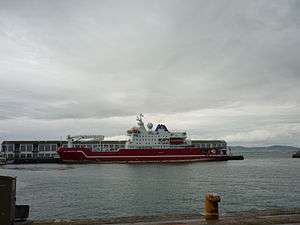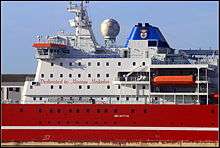S. A. Agulhas II
S. A. Agulhas II is a South African icebreaking polar supply and research ship owned by the Department of Environmental Affairs (DEA). She was built in 2012 by STX Finland Rauma shipyard in Rauma, Finland, to replace the ageing S. A. Agulhas, which was retired from Antarctic service in April 2012. Unlike her predecessor, S. A. Agulhas II was designed from the beginning to carry out both scientific research and supply South African research stations in the Antarctic.
 S. A. Agulhas II at Cape Town Harbour | |
| History | |
|---|---|
| Name: | S. A. Agulhas II |
| Owner: | Department of Environmental Affairs[1] |
| Port of registry: |
Cape Town, |
| Ordered: | 17 November 2009[1] |
| Builder: | STX Finland Rauma shipyard[2] |
| Cost: | R 1,300,000,000 |
| Yard number: | 1369[2] |
| Laid down: | 31 January 2011[1] |
| Launched: | 21 July 2011[2] |
| Completed: | 3 April 2012[1] |
| In service: | 2012–[2] |
| Identification: | |
| Status: | In service |
| General characteristics [1] | |
| Type: | Polar supply and research vessel |
| Tonnage: | |
| Displacement: | 13,687 tons[3] |
| Length: | 134.2 m (440 ft) |
| Beam: | 21.7 m (71 ft) |
| Draught: | 7.65 m (25.1 ft) |
| Depth: | 10.55 m (34.6 ft) |
| Ice class: | Polar Class 5 |
| Installed power: | 4 × Wärtsilä 6L32 (4 × 3,000 kW[4]) |
| Propulsion: |
|
| Speed: |
|
| Range: | 15,000 nautical miles (28,000 km; 17,000 mi) at 14 knots (26 km/h; 16 mph) |
| Capacity: | |
| Crew: | 45 |
| Aircraft carried: | 2 × Atlas Oryx[4] |
| Aviation facilities: | Helideck and hangar |
Development and construction

In November 2009 the South African Department of Water and Environmental Affairs signed a contract, worth R 1.3 billion (approximately US$170 million or 116 million euros) with STX Finland for the construction of a new polar research and supply vessel that would replace the ageing S. A. Agulhas, which was scheduled to be retired by 2012. The shipyard, located in Rauma, Finland, beat competing bids from Astellero Barreras from Spain, Damen Shipyards from the Netherlands and Keppelsingmarine from Singapore. The production began with the steel-cutting ceremony in September 2010.[5]
The keel of the new ship, referred to by her yard number as NB 1369, was laid down on 31 January 2011.[1] She was launched on 21 July 2011 and named S. A. Agulhas II.[2] S. A. Agulhas II conducted her open water sea trials in February 2012 and, in order to verify the results of model tests, ice trials in the Bay of Bothnia between 19 and 24 March. During the latter voyage the ship encountered level ice up to 0.6 metres (2.0 ft) thick and performed beyond expectations.[6] In addition the hull and machinery of the vessel were instrumented to measure full-scale ice loads, and in the future S. A. Agulhas II will be used as a research platform by companies and universities from Finland and South Africa to gain more knowledge about the interaction between ice and the ship.[7]
S. A. Agulhas II was handed over to the South African Department of Environmental Affairs on 4 April 2012 and left Finland for South Africa the following day. She arrived at her home port, Cape Town on 3 May, during a ceremony celebrating the arrival the ship was dedicated to the memory of singer Miriam Makeba.[8]
Design
General characteristics
The maximum overall length of S. A. Agulhas II is 134.2 metres (440 ft) and her length between perpendiculars is 121.25 metres (397.8 ft). The beam and depth of her hull are 21.7 metres (71 ft) and 10.55 metres (34.6 ft), respectively, and the maximum breadth of the ship is 22 metres (72 ft). The draught of S. A. Agulhas II is 7.65 metres (25.1 ft). Her displacement is 13,687 tons,[3] gross tonnage is 12,897, net tonnage 3,870 and deadweight tonnage 4,780 tons.[1] She is served by a crew of 45.
S. A. Agulhas II is classified by Det Norske Veritas with a class notation ![]()
Facilities
Unlike her predecessor, S. A. Agulhas II was built from the beginning as both a polar supply ship as well as a research vessel.[9] She has both onboard laboratories for scientific research as well as cargo holds and tanks for supplies for South African polar research stations. In addition she has accommodations for 100 passengers in 46 cabins[4] and facilities such as gym, library, business center and a 100-seat auditorium.[3]
S. A. Agulhas II has eight permanent and six containerized laboratories for different fields of marine, environmental, biological and climate research totaling 800 square metres (8,600 sq ft). Deep-water probes can be launched either via a large door in the side of the vessel or, if the ship is operating in ice-infested waters, through a 2.4-by-2.4-metre (7.9 by 7.9 ft) moon pool. A drop keel containing transducers for the measurement of plankton density and ocean currents can be lowered 3 metres (9.8 ft) below the bottom of the ship. A hydraulic A-frame in the stern of the ship can be used to tow sampling nets and dredges.[4]
To transport supplies to polar research stations, the ship has a 4,000-cubic-metre (140,000 cu ft) cargo hold located in the bow of the vessel. It is served by a 35-ton main crane and three 10-ton general cargo cranes, all of which can also be used to lower scientific equipment and vehicles on ice. When heavy loads are being lifted, a heeling tank is used to balance the vessel. S. A. Agulhas II is the first ship of her kind to be allowed to carry both passengers and fuel, such as polar diesel, Jet A helicopter fuel and petrol, as cargo.[4]
S. A. Agulhas II has a hangar and helideck capable of serving two Atlas Oryx or Aérospatiale SA 330 Puma helicopters. She also has two fast rescue craft, which are on standby during helicopter operations, and two fully enclosed lifeboats for 75 personnel.[3]
S.A. Agulhas II is fitted with a state of the art Raytheon Anschutz integrated bridge navigation system. The vessel maintains positioning during offloading at the ice shelf, as well as during scientific survey work, using a Navis Engineering DP4000 dynamic positioning system.
Power and propulsion
S. A. Agulhas II is powered by four six-cylinder Wärtsilä 6L32 medium-speed diesel generating sets, each producing 3,000 kW (4,000 hp).[4] To fulfill the International Maritime Organisation’s Safe Return to Port requirement, the main engines are located in two separate engine rooms and the ship is capable of returning to port with one engine room flooded.[3] Designed according to the power plant principle in which the main generators supply electricity for all shipboard consumers, S. A. Agulhas II has no separate auxiliary generators. In case of emergency, electricity is provided by a Volvo Penta emergency diesel generator.[1]
The ship has a diesel-electric powertrain with two Converteam 4,500 kW propulsion motors driving 4.5-metre (15 ft) KaMeWa controllable pitch propellers,[3] a relatively uncommon feature in diesel-electric ships which usually use fixed-pitch propellers. The propulsion system gives her a maximum speed of 16 knots (30 km/h; 18 mph) in open water,[4] but her service speed is slightly lower, and at 14 knots (26 km/h; 16 mph) her operating range is 15,000 nautical miles (28,000 km; 17,000 mi).[3] Furthermore, S. A. Agulhas II is designed to be able to break level ice with a thickness of 1 metre (3.3 ft) at 5 knots (9.3 km/h; 5.8 mph).[5] For dynamic positioning and manoeuvring in ports she has two Rolls-Royce bow thrusters and one stern thruster.[1]
See also
References
| Wikimedia Commons has media related to S. A. Agulhas II. |
- "S. A. Agulhas (30528)". DNV GL Vessel Register. Det Norske Veritas. Retrieved 5 April 2012.
- South African Polar vessel is launched Archived 17 September 2011 at the Wayback Machine. The Motor Ship, 21 July 2011. Retrieved 2011-12-02.
- R1.3bn icebreaker rounds off SA’s research investment south of Cape Agulhas. Engineering News, 6 March 2012. Retrieved 2012-04-06
- Official website Archived 2 May 2012 at the Wayback Machine
- SA Agulhas II handed over to South Africa. defenceWeb, 5 April 2012. Retrieved 2012-04-06
- Ice-breaker SA Agulhas II passes with flying colours. DailyNews, 27 March 2012. Retrieved 2012-04-06.
- SA Agulhas II helping Finns better understand hullforms. defenceWeb, 15 February 2012. Retrieved 2012-04-09.
- DefenceWeb – SA receives SA Agulhas II polar research ship
-
Dimakatso Motau (30 September 2011). "The SA Agulhas prepares for polar retirement". Engineering News. Archived from the original on 12 October 2011. Retrieved 12 October 2011.
The vessel will only be used closer to shore after retirement and it is insurable for another two years until 2014. The decision on how to use it after disposal lies with the prospective owner.
CS1 maint: BOT: original-url status unknown (link)
External links
- South African National Antarctic Programme - Owner's official website